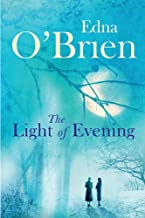The Light of Evening by Edna O’Brien is a deceptively complex book. It deals with relationships between two women, Dilly and Eleanora, who live very different lives some years apart. They are both women, but they come from different generations. They are both Irish, but they seem to belong to different countries, as well as different eras. They both leave their homeland to seek fortune, but on wholly different terms and to different places. They both seem to stumble into relationships with men, some of which involve marriage, and cope in partially successful ways with the challenges posed by maintaining the terms of engagement. The complications in the relationship between the two women, Dilly and Eleanora, arise because they are mother and daughter.
At the start, we meet Dilly, the mother, who is in hospital in Dublin. Her years have advanced. She is seriously ill and about to undergo a procedure. Her youth flashes before her sedated eyes. She travels from Ireland to the United States and we follow a developing life in New York as it moves from promised opportunity to promised opportunity, only to find that reality usually imposes its surprisingly mundane results. Wiser, but only marginally richer, Dilly soon finds herself repatriated for family reasons.
We meet Eleanora via scenes from her marriage. She too has left Ireland, but she has personal reasons and she has pursued education. She seems to be in control, at least potentially in control of her life options. She is apparently free to choose and we see her relocate for professional rather than menial reasons. But she seems to spend as much of her time and energy analyzing her relationships with men as pursuing her professional goals. The turns in her life are unpredictable, often unfathomable. They have a gloss of normality imposed by obvious consumption, personality created by likes and dislikes and achievement realized through opportunity. It is a life that presents a vivid contrast to the life of Dilly, whose own journey was imposed by a need to make a living first and a personal space second.
But the real complication arises because these two women, doing what women do a generation apart are mother and daughter. Letters exchanged form a major part of the book’s substance, specifically letters between mother and daughter. These letters often do not appear to say very much, but then that becomes a crucial point in the narrative. Deceptively simple, they can also deceive by not saying what the writer wants to say, by not communicating what the reader wants to hear.
Overall
the plot of Edna O’Brien’s novel dwells
almost exclusively on the nature of the relationship between mother and
daughter, the difference and similarities that make their lives. It travels the
world that surrounds their different generations, drawing sharp contrasts but
also recognizing remarkable similarities. It’s a
book that walks well-worn paths, but arrives at new experiences for the reader.
Rather than the substance of life, it is the spaces between, whether large or
small, that captivate. And, by the end, we realize that for all our
complications, we individuals are generally ruled by self and can often be
driven by quite mundane, but devastatingly relentless material concerns.





No comments:
Post a Comment